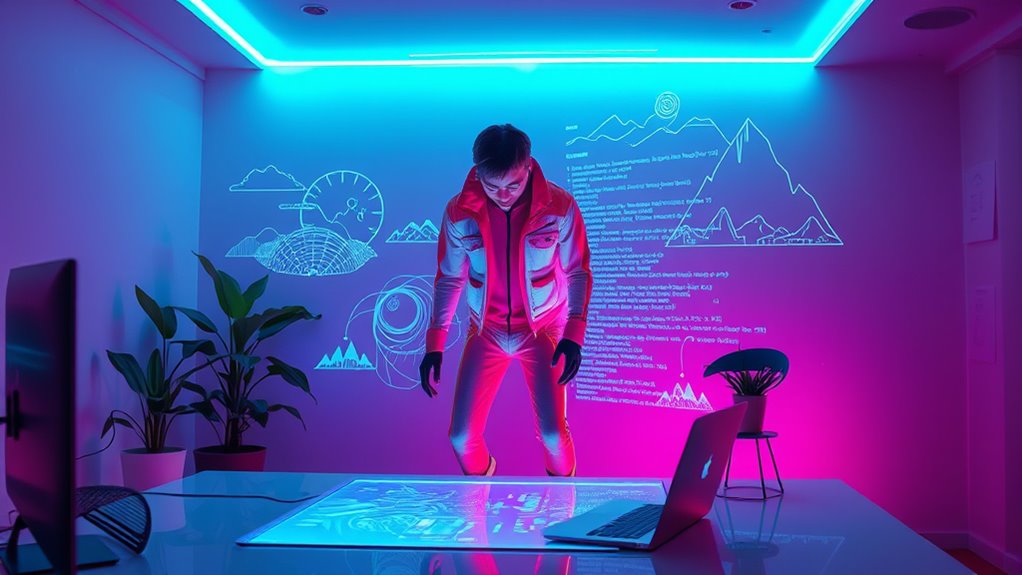Vibe coding could be the future of coding, shifting the focus from complex syntax to user experience and app functionality. With AI generating code from your natural language prompts, you can concentrate on your ideas instead of getting bogged down in technical details. This approach makes programming accessible to everyone, democratizing the development process. If you’re curious about how vibe coding is changing the industry and what it means for you, there’s more to explore.

As technology evolves, you might find yourself intrigued by the concept of vibe coding, an innovative approach to programming that lets you describe what you want in natural language while AI takes care of the coding details. Coined by Andrej Karpathy, a founding member of OpenAI, vibe coding fundamentally changes how we think about app development. Instead of getting bogged down in syntax and complex coding languages, you focus on the app’s functionality and user experience.
It’s a paradigm shift that democratizes programming, allowing anyone—even those with no technical background—to create apps.
With vibe coding, large language models (LLMs) come into play, generating code based on your natural language prompts. Imagine explaining your app idea to an AI assistant, which then translates your vision into working code. This not only simplifies the development process but also allows you to channel your energy into what really matters: the outcome of your application. You no longer need to wrestle with the intricacies of coding languages; instead, you let AI handle the technical implementation.
This shift has profound implications for education and training. Vibe coding could revolutionize how programming is taught by emphasizing creativity and problem-solving over rote memorization of code. Students can focus on generating ideas rather than getting lost in technical details, leading to innovative solutions. Vibe coding educational programs will likely need to adapt, prioritizing skills like design and user experience, which are essential in this new landscape.
In the industry, vibe coding could become the dominant approach thanks to advancements in AI. As developers begin to embrace this method, their roles may evolve towards more strategic or managerial tasks. The potential for increased productivity is enormous, as AI automates much of the coding process, allowing you to prototype and develop apps faster than ever before.
This focus on creativity encourages innovation, which is significant in a fast-paced tech landscape.
However, there are challenges to take into account. While AI handles basic debugging, human oversight remains necessary for more complex issues. Additionally, the effectiveness of vibe coding largely depends on the quality of AI tools.
Ethical concerns, including AI bias and data privacy, also warrant attention. As this approach develops, the demand for traditional coding skills might shift towards more specialized roles, reflecting the changing nature of the tech industry.
Ultimately, vibe coding not only reshapes coding itself but also how we envision the future of app development.
Frequently Asked Questions
What Is the Origin of the Term “Vibe Coding”?
The term “vibe coding” originated in early 2025, coined by AI researcher Andrej Karpathy.
It describes a process where you use AI to generate code through natural language inputs, allowing you to focus on ideas instead of syntax.
This approach makes software development more accessible, enabling both developers and non-developers to create applications without extensive coding knowledge.
It emphasizes collaboration between human creativity and AI’s coding capabilities, revolutionizing how you build software.
How Do I Get Started With Vibe Coding?
To get started with vibe coding, explore AI-powered tools like Cursor Composer or SuperWhisper that let you generate code using natural language.
Familiarize yourself with Large Language Models (LLMs) to automate your coding tasks. Practice describing what your software should do, allowing AI to handle the implementation.
Also, consider enrolling in courses that focus on AI-assisted programming, helping you understand this innovative approach while reducing the traditional coding barrier.
Are There Specific Tools for Vibe Coding?
Yes, there are several tools for vibe coding that you can explore.
Platforms like OpenAI’s Codex and ChatGPT allow you to input natural language prompts, and they generate code for you.
Other tools include Microsoft’s Power Apps and Google’s AutoML, which simplify app development through intuitive interfaces.
These tools make coding more accessible, letting you focus on what you want to achieve rather than getting bogged down in syntax.
Can Vibe Coding Replace Traditional Programming Languages?
Imagine if Shakespeare had a personal AI assistant to pen his plays.
Vibe coding can’t entirely replace traditional programming languages, but it shifts the landscape. You’ll find it enhances your workflow, letting you focus more on creativity than syntax.
However, it’s not a magic wand; understanding coding fundamentals remains essential.
While vibe coding democratizes software development, it’ll coexist with traditional methods, each serving unique roles in the evolving tech tapestry.
What Industries Are Adopting Vibe Coding Practices?
You’ll find vibe coding practices making waves across various industries.
In software development, it simplifies coding for non-techies.
UX design benefits from faster prototyping, enhancing creativity.
Education sees barriers lowered as complex syntax becomes less essential.
The creative sector thrives, letting you focus on ideas over technicalities.
Platforms like ChatGPT and Replit support this shift, encouraging broader participation and redefining roles, making coding more accessible than ever before.
Conclusion
So, as you immerse yourself in this new domain of vibe coding, you might just stumble upon a moment of inspiration while sipping your morning coffee or scrolling through your favorite social media feed. It’s funny how creativity often strikes when you least expect it. Embracing this unorthodox approach could redefine your coding experience, making it more intuitive and enjoyable. Who knew that tapping into your vibe could lead to groundbreaking innovations? The future of coding may be closer than you think!









